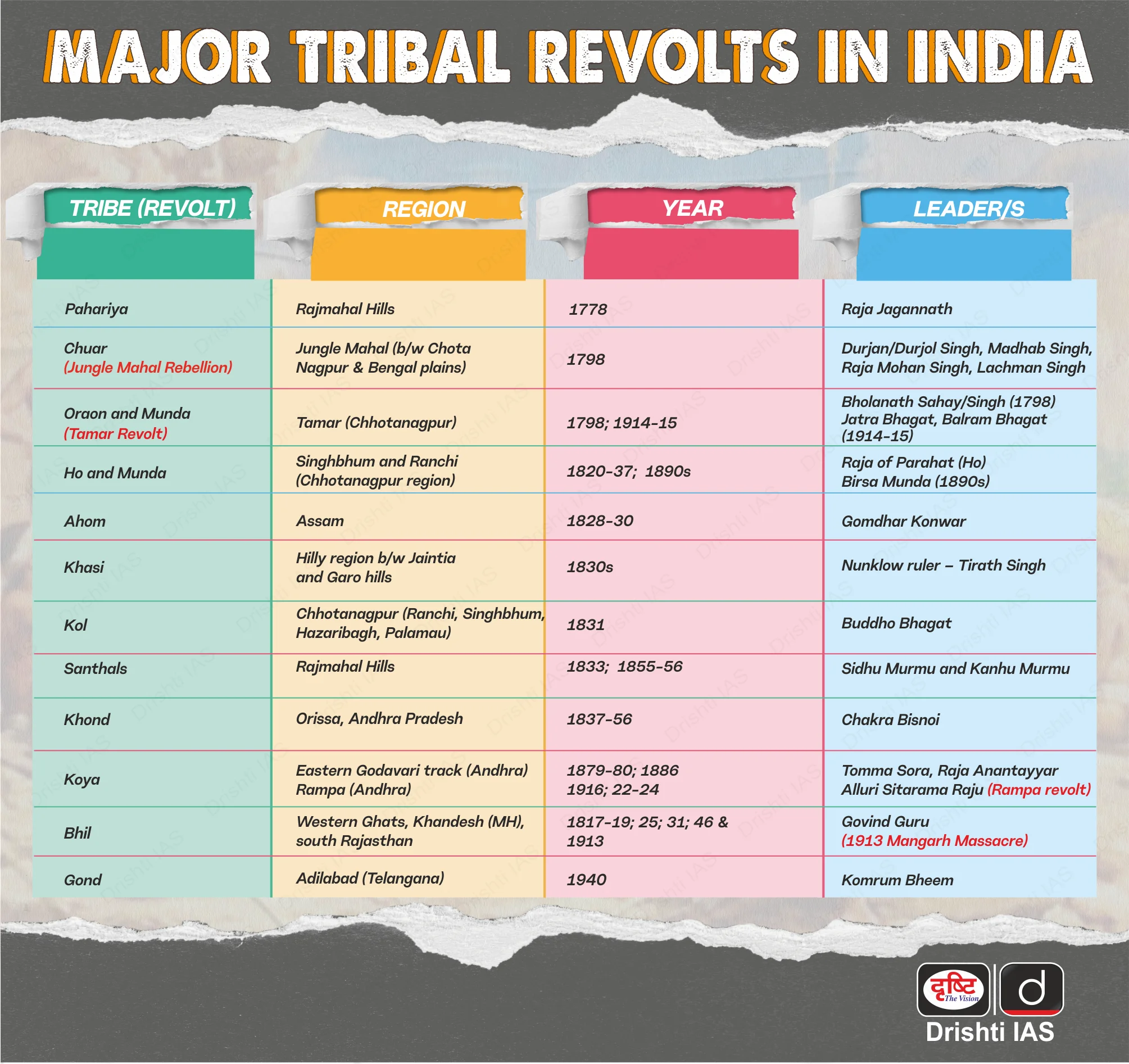Jharkhand
Hul Diwas 2025
- 01 Jul 2025
- 5 min read
Why in News?
On Hul Diwas (30th June, 2025), the Prime Minister paid tribute to the courage of India’s tribal communities and honoured the legacy of Santhal Hul tribal martyrs who resisted colonial rule.
Key Points
- About the Santhal Hul of 1855:
- Historical Background: The Santhal Hul of 1855 was one of the earliest peasant uprisings against British colonial rule in India. Led by four brothers - Sidho, Kanho, Chand, and Bhairav Murmu - along with sisters Phulo and Jhano, the revolt began on 30th June 1855.
- The revolt targeted not only the British but also upper castes, zamindars, darogas, and moneylenders, collectively termed 'diku'.
- It aimed to protect the economic, cultural, and religious rights of the Santhal community.
- Genesis of the Uprising:
- In 1832, certain areas were designated as ‘Santhal Pargana’ or ‘Damin-i-Koh’, which includes present-day Sahibganj, Godda, Dumka, Deoghar, Pakur, and parts of Jamtara, in present-day Jharkhand.
- The area was given to the Santhals who were displaced from various regions under the Bengal Presidency.
- The Santhals were promised settlement and agriculture in Damin-i-Koh, but instead they faced repressive land-grabbing and begari (bonded labour).
- Two systems of bonded labour emerged in Santhal territory, known as kamioti and harwahi.
- Under kamioti, the borrower had to work for the lender until the loan was repaid, while under harwahi, the borrower had to provide personal services and plough the lender's field as needed. The terms of the bond were so strict that it was nearly impossible for the Santhal to repay the loan in their lifetime.
- Two systems of bonded labour emerged in Santhal territory, known as kamioti and harwahi.
- In 1832, certain areas were designated as ‘Santhal Pargana’ or ‘Damin-i-Koh’, which includes present-day Sahibganj, Godda, Dumka, Deoghar, Pakur, and parts of Jamtara, in present-day Jharkhand.
- Guerrilla Warfare and Suppression:
- The Murmu brothers led around 60,000 Santhals in guerrilla warfare against the East India Company. Despite fierce resistance lasting six months, the revolt was crushed in January 1856 with severe casualties and devastation.
- More than 15,000 Santhals lost their lives, and over 10,000 villages were destroyed.
- The Hul highlighted early resistance against British colonial rule and remains a symbol of tribal resilience.
- The Murmu brothers led around 60,000 Santhals in guerrilla warfare against the East India Company. Despite fierce resistance lasting six months, the revolt was crushed in January 1856 with severe casualties and devastation.
- Impact: The uprising led to the enactment of the Santhal Pargana Tenancy Act of 1876 (SPT Act) prohibits transfer of Adivasi lands to non-Adivasis, allows land inheritance only within the community and preserves Santhals' right to self-govern their land.
- Historical Background: The Santhal Hul of 1855 was one of the earliest peasant uprisings against British colonial rule in India. Led by four brothers - Sidho, Kanho, Chand, and Bhairav Murmu - along with sisters Phulo and Jhano, the revolt began on 30th June 1855.
Santhal Tribe
- Demographic Distribution:
- The Santhal are one of the largest tribal communities in India.
- They are primarily concentrated in Jharkhand, Bihar, West Bengal, and Odisha.
- Language:
- Santhals speak Santhali, a dialect of Kherwari, which belongs to the Munda branch of the Austroasiatic language family.
- Occupations and Livelihood:
- Many Santhals work in coal mines near Asansol (West Bengal) and steel factories in Jamshedpur (Jharkhand).
- Some work seasonally as agricultural labourers.
- In rural areas, rice cultivation forms the core of their economic activity.
- Village Administration:
- Each Santhal village is headed by a hereditary headman, supported by a council of elders.
- The headman also performs religious and ceremonial duties.
- A group of villages forms a pargana, governed by another hereditary headman.
- Clan and Social Structure:
- The Santhal have 12 clans, each further divided into patrilineal subdivisions.
- Clan exogamy is strictly observed—members of the same clan do not marry each other.
- Clan and subclan membership comes with specific rules about dress, food, housing, and rituals.
- Monogamy is the norm among Santhals. While polygyny is allowed, it remains rare.
- Religion and Beliefs:
- Santhals traditionally worship spirits and place strong emphasis on ancestral cults, especially those of clan headmen.
- Spiritual practices and rituals form a central part of their cultural identity.







